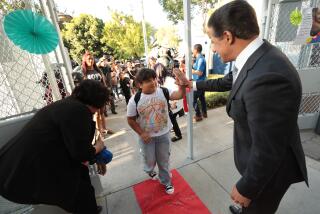Hard Times, Smart Schools
Although the news from the Public Policy Institute of California seemed, at first glance, unhelpful -- focused on how hard it would be for schools in the state to improve without a lot more money -- tucked deep down in the nonprofit group’s long, recent report were more thoughtful ideas.
These could guide California’s schools until more bountiful times arrive. The available educational research gives mixed signals about whether more money equals better learning. The studies also are in a muddle over how new money should be spent.
The state’s new Quality Education Commission is supposed to begin a yearlong examination to peg academic goals to funding. But the commission would be smarter to take the opposite approach.
Look at what works with existing budgets. Examine creative or common-sense practices at schools that improve year after year, and create ways for other schools to put those ideas into place. For example:
* At one rural Northern California school, the principal took seriously the state ban on social promotion and enforced it to ensure that students moved on only if they grasped material as they were supposed to. Teachers also set up special repeat-year “academies” to teach material in new ways to those who were held back, rather than repeating failed lessons. The school’s performance has improved steadily over the years.
* A school in a farm worker community sends 70% of its poor Latino students to four-year colleges just by absolutely expecting them to enroll. Recent studies show that if teachers have higher expectations for their charges, the students tend to have higher achievements.
* One urban principal uses her school’s federal Title I money to lengthen the instructional day, and has seen scores rise consistently. Another has good results using Title I money for full-day kindergarten.
* A recent University of Michigan study found that when teachers use their time to teach, rather than chatting about fun but nonacademic topics, their students learn more. Ridiculously obvious perhaps, but many teachers need to be reminded of this.
Not every innovative program works at every school. But the Quality Education Commission is in a great spot to offer educators and schools a range of ideas that work at creative, successful schools.
Struggling schools could pick an idea or two that their staffs find exciting -- and find new ways to keep up the improvement reflected in the most recent set of Academic Performance Index scores. That would help both students and taxpayers’ money be smarter.
More to Read
Sign up for Essential California
The most important California stories and recommendations in your inbox every morning.
You may occasionally receive promotional content from the Los Angeles Times.










